(Reproduced from the Centers for Disease Control and Prevention. http://www.dpd.cdc.gov/dpdx/html/babesiosis.htm.)
a. AIDS patients
b. Foresters
c. Splenectomized patients
d. Transfusion recipients
e. Transplant recipients
376. An AIDS patient (CD4 count < 200/μL) presents to his primary care physician with a 2-week history of watery, nonbloody diarrhea. Acid-fast staining demonstrates oocysts in fresh stool seen in the figure below. Which of the following is the most likely diagnosis?
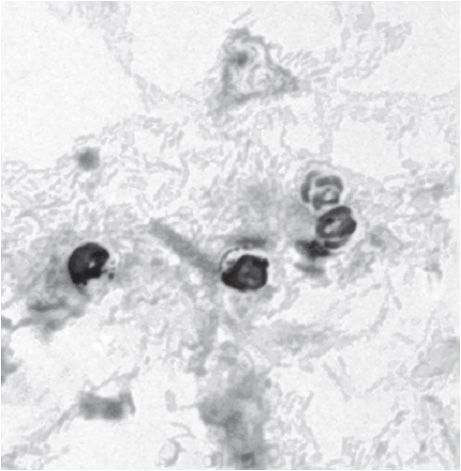
(Reproduced from the Centers for Disease Control and Prevention. Public Health Image Library, ID# 7829. http://phil.cdc.gov/phil/details.asp.)
a. Acid-fast bacilli
b. Enterocytozoon
c. Cryptosporidium
d. Entamoeba histolytica
e. Yeast
377. Flagellate parasite is the cause of vaginalis in women in temperate areas. It is a sexually transmittable disease. The prominent symptom is copious fowl-smelling yellow discharge that can be accompanied by cervical lesions and abdominal pain. What parasite does this represent?
a. Entamoeba histolytica
b. Trichomonas vaginalis
c. Strongyloides stercoralis
d. Schistosoma mansoni
e. Balantidium coli
378. A 30-year-old female stores her contact lenses in tap water. She notices deterioration of vision and visits an ophthalmologist, who diagnoses her with severe retinitis. Culture of the water as well as vitreous fluid would most likely reveal which of the following?
a. Acanthamoeba
b. Babesia
c. Entamoeba coli
d. Naegleria
e. Pneumocystis
379. A young nurse in a South American city located in the tropics develops classical symptoms of malaria. An accurate diagnosis of the Plasmodium species is necessary to provide the best treatment to insure recovery and prevent relapse. Sporozoites from a mosquito bite rapidly enter live cells where asexual merozoites enter the blood stream and RBCs are invaded. This erythrocytic stage provides a basis for laboratory diagnosis. Which of the diagnostic characteristics of P. falciparum is best described by the following?
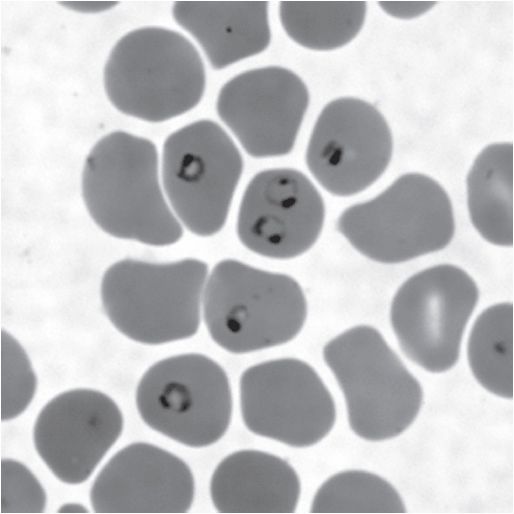
(Reproduced from the Centers for Disease Control and Prevention. http://www.dpd.cdc.gov/dpdx/html/Malaria.htm.)
a. An important diagnostic feature is the irregular appearance of the edges of the infected red blood cell
b. A period of 72 hours is required for the development of the mature schizont, which resembles a rosette with only 8 to 10 oval merozoites
c. Except in infections with very high parasitemia, only ring forms of early trophozoites and the gametocytes are seen in the peripheral blood
d. Schüffner dot stippling is routinely seen in red blood cells that harbor parasites
e. The signet-ring-shaped trophozoite is irregular in shape with amoeboid extensions of the cytoplasm
380. After returning from a wilderness camping outing, several children report watery, greasy, and foul-smelling stools. The life cycle of the parasite responsible for this outbreak consists of two stages: the cyst and the trophozoite. Which of the following is the most likely identification of this organism?

(A) “Face” and (B) “profile” of vegetative forms; (C, D) cysts (binucleate [D] and quadrinucleate stages). 2000×. (Reproduced, with permission, from Brooks GF et al. Jawetz’s Medical Microbiology. 24th ed. New York, NY: McGraw-Hill; 2007:660.)
a. Clonorchis
b. Entamoeba
c. Giardia
d. Pneumocystis
e. Trichomonas
381. A working mother takes her 4-year-old child to a day-care center. She has noticed that the child’s frequent stools are nonbloody with mucus and are foul smelling. The child has no fever, but does complain of “tummy hurting.” The increase of fat in the stool directs the pediatrician’s concern toward a diagnosis of malabsorption syndrome associated with which of the following?
a. Amebiasis
b. Ascariasis
c. Balantidiasis
d. Enterobiasis
e. Giardiasis
382. The proglottid was purged from the intestinal tract of an individual who recently immigrated to United States from Nicaragua. The proglottid measured 10 mm in length. What species does it represent?
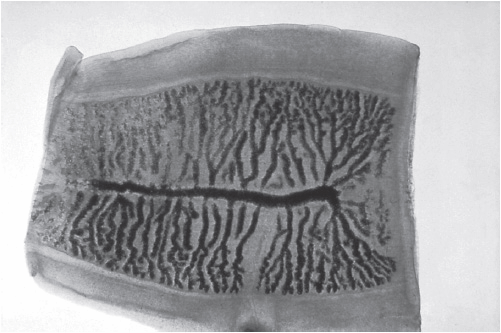
(Reproduced from the Centers for Disease Control and Prevention. Public Health Image Library, ID# 5259. http://phil.cdc.gov/phil/details.asp.)
a. Diphyllobothrium latum
b. Dipylidium caninum
c. Taenia saginata
d. Taenia solium
e. Echinococcus granulosus
383. Many of the POWs who were held captive in the Far East during the WWII contracted various parasitic infections, especially those prisoners who were forced to work on the infamous Thai-Burma railway. The tropical jungle environment of the Burma (Myanmar) railway project provided perfect conditions for development of the infective stage of a parasite larva, which infected the POWs through the soles of their poorly shod feet as they worked. In patients who have this chronic infection and are on chronic corticosteroid therapy, a syndrome can occur which results in high mortality rates. Which of the following parasites is most likely to be the culprit?
a. Ancylostoma duodenale
b. Ascaris lumbricoides
c. Diphyllobothrium latum
d. Strongyloides stercoralis
e. Taenia solium
384. Several diagnostic tests for antibodies to Toxoplasma are directly compared for sensitivity and specificity against the sera of 100 healthy adults. While differences are apparent in the accuracy of the tests, it is able to conclude that 80% of those tested have IgG antibodies against Toxoplasma. Which of the following is most compatible in helping to explain this finding?
a. A variety of parasitic infections induce the formation of Toxoplasma antibody
b. The IgM test is more reliable than the IgG test for determination of past infections; retesting for IgM would show that most people do not have Toxoplasma antibody
c. The potential for Toxoplasma infection is widespread, and the disease is mild and self-limiting
d. The test for Toxoplasma antibodies is highly nonspecific
e. Toxoplasmosis is caused by eating meat; therefore, all meat eaters have had toxoplasmosis
385. A 32-year-old homosexual man presents to his physician with non-bloody, foul-smelling, greasy stools 3 weeks after traveling to Mexico. While certain enteric protozoan and helminthic infections have been long related to contaminated food or water, sexual transmission of these diseases has produced a “hyperendemic” infection rate among homosexual males. Which of the following organisms is the most likely etiologic cause of this patient’s diarrhea?
a. Amebiasis
b. Ascariasis
c. Enterobiasis
d. Giardiasis
e. Trichuriasis
386. Analysis of a patient’s stool reveals small structures resembling rice grains; microscopic examination shows these to be proglottids. Which of the following is the most likely organism in this patient’s stool?
a. Ascaris lumbricoides
b. Enterobius vermicularis
c. Necator americanus
d. Taenia saginata
e. Trichuris trichiura
387. An AIDS patient complains of headaches and disorientation. A clinical diagnosis of Toxoplasma encephalitis is made, and Toxoplasma cysts are observed in a brain section. Which of the following antibody results would be most likely in this patient?
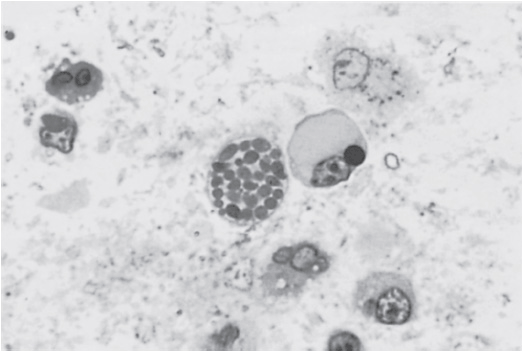
a. IgM nonreactive, IgG nonreactive
b. IgM nonreactive, IgG reactive (low titer)
c. IgM reactive (low titer), IgG reactive (high titer)
d. IgM reactive (high titer), IgG reactive (high titer)
e. IgM reactive (high titer), IgG nonreactive
388. A young boy from an impoverished area in Argentina presents to a public health clinic with Romana sign and a chagoma lesion. Several reduviid insects from the home are shown to the health care workers. In the chronic stage of this disease, where are the main lesions usually observed?
a. Digestive tract and respiratory tract
b. Heart and digestive tract
c. Heart and liver
d. Liver and spleen
e. Spleen and pancreas
389. A woman who recently returned from Africa complains of having paroxysmal attacks of chills, fever, and sweating. These attacks last a day or two at a time and recur every 36 to 48 hours. Examination of a stained blood specimen reveals ringlike and crescent-like forms within red blood cells. Which of the following is the most likely infecting organism?
a. Plasmodium falciparum
b. Plasmodium vivax
c. Schistosoma mansoni
d. Trypanosoma gambiense
e. Wuchereria bancrofti
Questions 390 and 391
390. A young man, who recently returned to the United States from Vietnam, has severe liver disease. Symptoms include jaundice, anemia, and weakness. Which of the following is the most likely etiologic agent shown in the figure below?

(Reproduced from the Centers for Disease Control and Prevention. http://www.dpd.cdc.gov/dpdx/html/clonorchiasis.htm.)
a. Clonorchis sinensis
b. Diphyllobothrium latum
c. Plasmodium falciparum
d. Taenia saginata
e. Taenia solium
391. An intermediate form of the organism shown in the photomicrograph (Question 390) lives in which of the following?
a. Cows
b. Mosquitoes
c. Pigs
d. Snails
e. Ticks
392. A woman who recently traveled through Central Africa now complains of severe chills and fever, abdominal tenderness, and darkening urine. Her febrile periods last for 28 hours and recur regularly. Which of the following blood smears would most likely be associated with the symptoms described?
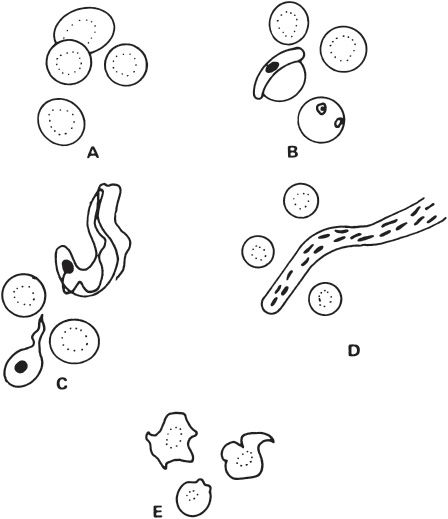
a. A
b. B
c. C
d. D
e. E
393. A young woman reports to her physician with possible urinary tract infection. The doctor finds the vagina and cervix tender, inflamed, and covered with a frothy yellow discharge. Which of the following protozoa described in this case is known to exist only in the trophozoite stage?
a. Balantidium coli
b. Entamoeba histolytica
c. Giardia lamblia
d. Toxoplasma gondii
e. Trichomonas vaginalis
394. An international photographer returns to the United States from a global picture assignment. He is seen by his physician, giving his major complaint as diarrhea. Which of the following can be ruled out?
a. Echinococcus granulosus
b. Dientamoeba fragilis
c. Diphyllobothrium latum
d. Giardia lamblia
e. Leishmania donovani
395. A medical technologist visits Scandinavia and consumes raw fish daily for 2 weeks. Six months after her return home, she has a routine physical and is found to be anemic. Her vitamin B12 levels were below normal. Which of the following is the most likely cause of her vitamin B12 deficiency anemia?
a. Cysticercosis
b. Excessive consumption of ice-cold vodka
c. Infection with Diphyllobothrium latum
d. Infection with Parvovirus B19
e. Infection with Yersinia
396. A renal transplant patient is admitted for graft rejection and pneumonia. A routine evaluation of his stool shows rhabditiform larvae. Subsequent follow-up reveals similar worms in his sputum. He has no eosinophils in his peripheral circulation. Which of the following is the most likely organism?
a. Ascaris lumbricoides
b. Hymenolepis nana
c. Loa loa
d. Necator americanus
e. Strongyloides stercoralis
397. A 56-year-old male immigrant from Bolivia complains of abdominal pain and cramping. He comments that 2 months previous to his current problems, he had numerous bloody stools every day. Physical findings include right upper quadrant pain over the liver with hepatomegaly, and a liver biopsy is performed. Which of the following parasites would most likely be identified in the liver biopsy?
a. Acanthamoeba castellanii
b. Ascaris lumbricoides
c. Balantidium coli
d. Entamoeba histolytica
e. Taenia solium
398. Human malarial infections start with the bite of a mosquito, and patients may experience the periodic paroxysms of this infection due to events that occur in the bloodstream. Up to one million deaths worldwide have been estimated annually. Which of the following control methods for this disease is currently most effective?
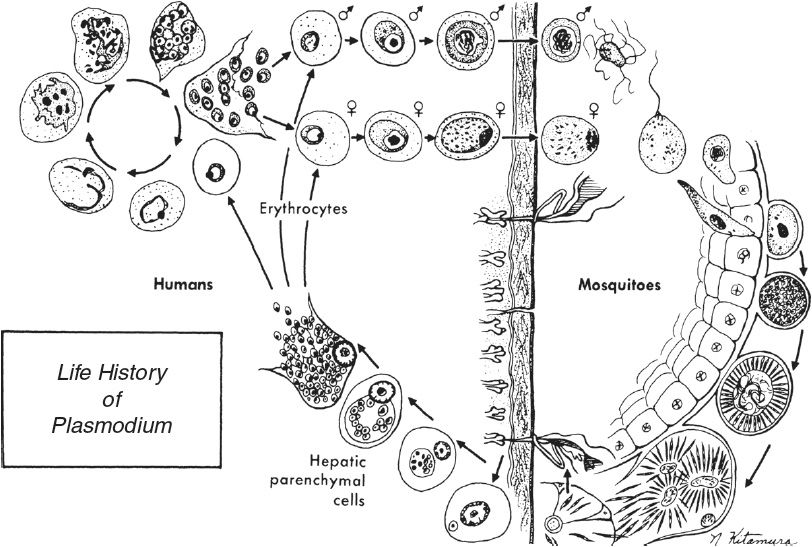
a. Antibiotics
b. A vaccine
c. Chemoprophylaxis
d. Tick repellents
e. White clothing
399. An African local clinic reports seeing increased cases of central nervous system (CNS) involvement in patients. Genetically induced changes in the glycoprotein coat of which one of the following organisms enhances its escape from the host’s immune antibody response by having genes that encode multiple, variant surface glycoproteins?
a. Trichinella spiralis
b. Trichomonas vaginalis
c. Toxoplasma gondii
d. Trypanosoma gambiense
e. Leishmania donovani
400. Human parasitic amoebas are usually ingested for transmission. In less acute disease, patients may experience abdominal tenderness, abdominal cramps, nausea, vomiting, and diarrhea. Which of the following best describes these intestinal amebas?
a. Infection with E. histolytica is limited to the intestinal tract
b. They are usually nonpathogenic
c. They are usually transmitted as trophozoites
d. They can cause peritonitis and liver abscesses
e. They occur most abundantly in the duodenum
401. Infection with Schistosoma haematobium, based on the presence of eggs in urine, is identified in an Egyptian farmer’s infection, which has caused dermatitis, fever, and chronic filero-obstructive disease. These symptoms are the result of granulomatous reactions to the ova or to products of the parasite at the place of oviposition. Which of the following clinical manifestations can be routinely observed in these infections?
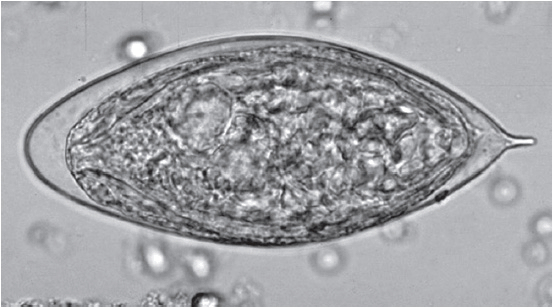
(Reproduced from the Centers for Disease Control and Prevention. http://www.dpd.cdc.gov/dpdx/html/Schistosomiasis.htm.)
a. Arthropathies
b. Bladder wall hyperplasia
c. Cardiac abnormalities
d. Pulmonary embolism
e. Hemorrhagic cystitis
402. A boy scout troop goes camping in a New England forest area in the late spring. Two weeks later, several of the boys present with erythema migrans lesions but no other clinical manifestations. Borrelia burgdorferi, the causative agent of Lyme disease, has been isolated from a variety of ticks such as I. scapularis, Amblyomma, Dermacentor, and I. pacificus. Which of the following statements most accurately describes Lyme disease?
a. Dermacentor and Amblyomma are significant vectors of B. burgdorferi to humans.
b. Dogs and cats are naturally immune to Lyme disease
c. Ixodes scapularis and I. dammini are different types of ticks
d. Only a small percentage of people who get bitten by a tick develop Lyme disease
e. White-tailed deer, an important reservoir for I. scapularis, are dying because of Lyme disease
403. A male patient in a tropical environment has eosinophilia during acute inflammatory episodes of his illness, but this is not considered to be the definitive diagnostic feature to determine what is causing his disease. Transmission of human parasites may occur via ingestion of contaminated food, water, snails, a variety of insects, and possibly even through pets or rat ectoparasites. Which of the following requires a mosquito for transmission?
a. Babesiosis
b. Bancroftian filariasis
c. Dog tapeworm
d. Guinea worm
e. Leishmaniasis
404. A Brazilian farmer presents to his medical clinic with hepatosplenomegaly with ascetic fluid in the peritoneal cavity. His liver is studded with white granulomas. He is treated with praziquantel. Which of the following organisms is endemic in Africa and South/Central America and is transmitted by skin penetration (by eggs with a large lateral spine), resulting in a dermatitis and katayama fever (serum sickness-like syndrome with fever, lymphadenopathy, and hepatosplenomegaly)?
a. Clonorchis sinensis
b. Paragonimus westermani
c. Schistosoma haematobium
d. Schistosoma japonicum
e. Schistosoma mansoni
405. The adults in a village in southern China suffer from fever, chills, mild jaundice, eosinophilia, and liver enlargement. Which of the following organisms may be ingested with raw fish, often resulting in an asymptomatic infection but, with a heavy infection, may cause biliary and bile duct obstruction and has an operculated egg?
a. Clonorchis sinensis
b. Paragonimus westermani
c. Schistosoma haematobium
d. Schistosoma japonicum
e. Schistosoma mansoni
406. Which of the following organisms is endemic in Asia, and has a small lateral egg spine, and in chronic disease may result in hepatosplenic disease, portal hypertension, and liver granulomas?
a. Clonorchis sinensis
b. Paragonimus westermani
c. Schistosoma haematobium
d. Schistosoma japonicum
e. Schistosoma mansoni
407. An African rice farmer, who depends on irrigation water from a regional lake, develops hematuria and dysuria severe enough to have concern for renal failure. Which of the following organisms has large terminal egg spines, may cause a chronic granulomatous bladder disease with urethral obstruction, chronic renal failure, and may be detected via eggs in the urine?
a. Clonorchis sinensis
b. Paragonimus westermani
c. Schistosoma haematobium
d. Schistosoma japonicum
e. Schistosoma mansoni
408. Campers in a European forest area drink unfiltered stream water and later experience abdominal cramps with foul-smelling and greasy stools. Giardia lamblia infection can occur by ingesting as few as 10 eggs, resulting in asymptomatic cyst passage, self-limited diarrhea, or chronic diarrhea with associated malabsorption and weight loss, This infection is best diagnosed by which of the following?
a. Baermann technique
b. Dilution followed by egg count
c. Enzyme immunoassay (EIA)
d. Using a scotch tape method
e. Sigmoidoscopy and aspiration of mucosal lesions
409. Patients with E. histolytica have an asymptomatic carrier rate greater than 90%. Chronic disease (intermittent bloody diarrhea and abdominal pain from months to years) is often difficult to distinguish from inflammatory bowel disease. E. histolytica infection is best diagnosed by which of the following?
a. Baermann technique
b. Dilution followed by egg count
c. EIA
d. Examination of a cellophane tape swab
e. Sigmoidoscopy and aspiration of mucosal lesions
410. Many patients with Strongyloides low worm burden are asymptomatic. Initial infection occurs by skin penetration and a pulmonary migration occurs. Patients demonstrate dry cough, wheezing, low-grade fever, dyspnea, and hemoptysis. Treatment is available for parasite eradication. Which is the best method listed below for detecting Strongyloides larvae?
a. Baermann technique
b. Dilution followed by egg count
c. EIA
d. Examination of a cellophane tape swab
e. Sigmoidoscopy and aspiration of mucosal lesions
411. Ascaris lumbricoides are large worms that have a complex life cycle in human hosts involving the digestive system, bloodstream, heart and liver, pulmonary circulation, and back to the small intestine. Serious medical complications may occur in any of these sites making diagnosis critical. Ascaris is best observed in human specimens by which one of the following?
a. Baermann technique
b. Dilution followed by egg count
c. EIA
d. Examination of a cellophane tape swab
e. Sigmoidoscopy and aspiration of mucosal lesions
412. A butcher develops a questionable habit of eating various kinds of raw, ground meat over several years. He eventually starts suffering from fatigue and lymphadenopathy. In his extensive physical examination, intensely white focal retinal lesions with vitritis are observed. Chorioretinitis is diagnosed, even though an older laboratory test, the Sabin–Feldman dye test, is found positive. This patient is found to be infected with which of the following?
a. Giardiasis
b. Schistosomiasis
c. Toxoplasmosis
d. Trichinosis
e. Visceral larva migrans
413. One week after eating bear meat, a fur trapper develops diarrhea, nausea, and vomiting. The next week, he experiences systemic symptoms of fever, myalgias, and malaise. His doctor notes periorbital edema and swollen eyelids, and laboratory tests report an eosinophilia. He is diagnosed with which of the following?
a. Giardiasis
b. Schistosomiasis
c. Toxoplasmosis
d. Trichinosis
e. Visceral larva migrans
414. A newspaper correspondent is sent to St Petersburg, Russia, to cover political events occurring there. She drinks only bottled water except on a side trip to the countryside to visit an old monastery. Two weeks later and at home, she develops a chronic diarrhea where the stools are watery, greasy, and foul smelling. Which of the following is the most likely diagnosis?
a. Giardiasis
b. Schistosomiasis
c. Toxoplasmosis
d. Trichinosis
e. Visceral larva migrans
415. A retired air force colonel has had abdominal pain for 2 years; he makes yearly freshwater fishing trips to Puerto Rico and often wades with bare feet into streams. Which of the following should be included in the differential diagnosis?
a. Giardiasis
b. Schistosomiasis
c. Toxoplasmosis
d. Trichinosis
e. Visceral larva migrans
416. A teenager who works in a dog kennel after school for 2 years has had a skin rash, eosinophilia, and an enlarged liver and spleen. Which of the following is the most likely cause of this infection?
a. Giardiasis
b. Schistosomiasis
c. Toxoplasmosis
d. Trichinosis
e. Visceral larva migrans
417. A young woman goes to her doctor with a variety of medical complaints. Her mucosal surfaces are tender, inflamed, eroded, and covered with a yellow discharge. For one problem, the laboratory reports the isolation of a pear-shaped protozoan with a jerky motility. This organism is observed in which of the following?
a. Biopsied muscle
b. Blood
c. Duodenal contents
d. Sputum
e. Vaginal secretions
418. A hunter, successful in his first black bear hunt, takes the meat home to eat. After consuming meals including bear meat over several weeks, two family members develop a flu-like syndrome and mild diarrhea. Several weeks later, two others have fever, GI distress, eosinophilia, muscle pain, and periorbital edema. Which of the specimens listed below would most easily detect the organism responsible for the clinical presentations described?
a. Biopsied muscle
b. Blood
c. Duodenal contents
d. Sputum
e. Vaginal secretions
419. A family of four goes on a vacation for 3 weeks to Central and South America. They consume the usual diets in all the areas they visit, including raw and pickled crustacean. Weeks later, two members produce brown sputum when coughing, hemoptysis, and eosinophilia, while the others are asymptomatic. A tissue-dwelling trematode causing this may be found in feces and which of the following?
a. Biopsied muscle
b. Blood
c. Duodenal contents
d. Sputum
e. Vaginal secretions
420. A forest ranger who routinely drinks untreated stream water and develops minor, intermittent diarrhea, which becomes chronic. Laboratory examination of several stools fails to determine any specific organism. Her physician decides to use the Entero-Test to try to discover the agent causing the symptoms. Cysts of a protozoan adhere to a piece of nylon yarn coiled in a gelatin capsule, which is swallowed. These cysts are usually found in which of the following?
a. Biopsied muscle
b. Blood
c. Duodenal contents
d. Sputum
e. Vaginal secretions
421. A person from Nantucket Island, Massachusetts, develops fever, fatigue, sweats, and arthralgia after hiking with friends in a forest. His physician finds evidence of tick bites that had not been noticed. A parasite resembling malaria that infects both animals and humans and is carried by the same tick that transmits B. burgdorferi (the Gram-negative spirochete that causes Lyme disease) would most likely be observed in which of the following?
a. Biopsied muscle
b. Blood
c. Duodenal contents
d. Sputum
e. Vaginal secretions
422. A patient with AIDS returns from Haiti with acute diarrhea. The stool reveals an oval organism (8-9 μm in diameter) that is acid-fast and fluoresces blue under ultraviolet light. The most likely identification of this organism is which of the following?
a. Cryptosporidium hominis
b. Cyclospora cayetanensis
c. Enterocytozoon bieneusi
d. Giardia lamblia
e. Prototheca wickerhamii
423. A 64-year-old sheepherder from the farming region of central California is rushed to the emergency room in anaphylactic shock. The history, as told by the ambulance medic, is that the man was hit in the abdomen during a barroom brawl. Ultrasound reveals a large cyst mass in the liver. A cautious needle aspiration of the liver mass reveals “hydatid sand.” Which of the following is the most likely agent involved?
a. Ascaris lumbricoides
b. Clonorchis sinensis
c. Echinococcus granulosus
d. Fasciolopsis hepatica
e. Schistosoma mansoni
424. In a boy from Iraq, a lesion shown below was found to be irritated, with intense itching and begins to enlarge and ulcerate but did heal spontaneously. However, a permanent scar was left at the site. What would be your diagnosis?
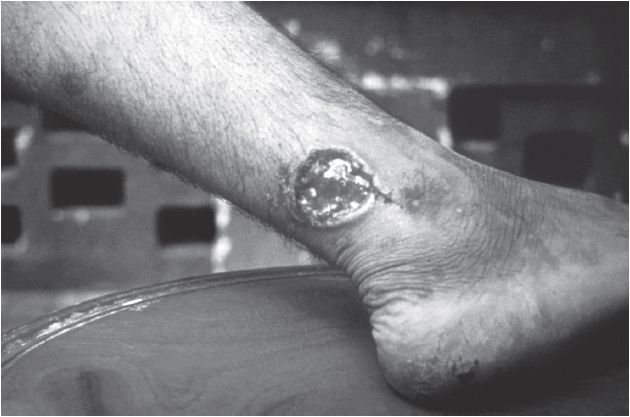
(Reproduced from the Centers for Disease Control and Prevention. Public Health Image Library, ID# 15069. http://phil.cdc.gov/phil/details.asp.)
a. Schistosoma mansoni infection
b. Cutaneous leishmaniasis (L. tropica)
c. Mucocutaneous leishmaniasis (L. braziliensis)
d. American trypanosomiasis (T. cruzi)
e. Inflammation due to a tick bite
425. A tiny worm was passed in the stool of a 6-year-old child. The child reported perianal pruritus, especially at night. The worm measured 10 mm in length and had a pointed tail. The eggs recovered by “Scotch tape” method. What species does it represent?
a. Ascaris lumbricoides
b. Enterobius vermicularis
c. Necator americanus
d. Schistosoma mansoni
e. Trichuris trichiura
426. A 12-year-old boy, a recent immigrant from Ethiopia, presented with abdominal pain associated with abdominal distention, nausea, and vomiting. The physician noted an enlarged liver with a palpable mass in the right upper quadrant of abdomen. Radiology was ordered; ultrasonography and computed tomography (CT) revealed a hepatic cyst. Microscopic examination of a biopsy specimen confirmed the diagnosis of a parasitic infection. What is the causative agent of this disease?
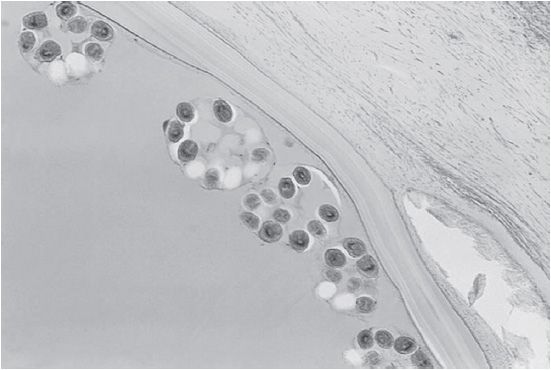
(Reproduced from the Centers for Disease Control and Prevention. Public Health Image Library, ID# 1452. http://phil.cdc.gov/phil/details.asp.)
a. Hymenolepis nana
b. Schistosoma haematobium
c. Echinococcus granulosus
d. Cysticercosis
e. Schistosoma japonicum
427. A 23-year-old woman who was a pig farmer in Peru but had lived in the United States for over 15 years presented with a 2-month history of left-side weakness and onset of seizures. An MRI of the patient’s head revealed cysts in parietal lobe. What is your diagnosis?
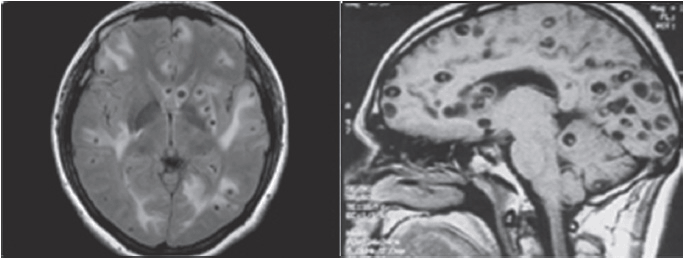
(Reproduced from the Centers for Disease Control and Prevention. http://www.cdc.gov/parasites/cysticercosis/.)
a. Toxoplasma gondii
b. Entamoeba histolytica
c. Neurocysticercosis
d. Strongyloides stercoralis
e. Acanthamoeba castellanii
Stay updated, free articles. Join our Telegram channel

Full access? Get Clinical Tree


